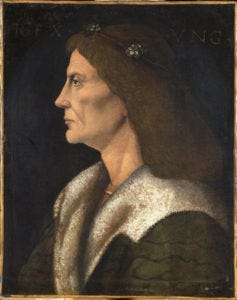Queen Beatrice of Aragon (1457-1508)
Queen Beatrice of Aragon died in Naples on September 23, 1508. She was the wife of King Hunyadi Mátyás alias Matthias (reigned 1458-1490) of Hungary and for a short time of King Ulászló II (reigned 1490-1516). Beatrice (or Beatrix) proved to be one of the most unpopular queens of all time, not only because of her childlessness but also because of her alleged lust for power and intrigues.
The second wife of King Matthias Hunyadi, she was born in 1457 to King Ferdinand I of Naples (r. 1458-1494). As the court of the Aragonese dynasty in southern Italy was a bastion of Renaissance culture at the time, Beatrix received a very distinguished upbringing, and her careful education later played a very important role not only in her noble marriage but also in the birth of Hungarian Latinism.
After the death of Matthias’s first wife, Catherine of Podjebrad, in 1464, the monarch was unable to find a new wife, and although Beatrix of Aragon had been promised to two Italian princes, the 17-year-old princess finally became the bride of the Hungarian king.
Two years after the proposal, in the fall of 1476, Beatrix and her large court traveled to Hungary, and in December the royal couple were married in a lavish ceremony.
The arrival of the Neapolitan princess brought radical changes to Visegrád, as Beatrix, accustomed to Italian etiquette, switched from an open and direct court to a more representative – and at the same time more reserved – court life.
The queen later became unpopular for many other reasons, the most important of which was that Beatrix was unable to produce an heir to the throne for 14 years, probably because of her infertility.
At the same time, Beatrix’s arrival had a number of positive effects: thanks to her, several famous figures of the Italian Renaissance visited Hungary in the last decade of Matthias’s reign: for example, the historians Antonio Bonfini and Petrus Ransanus, Diomede Caraffa and Roberto Caracciolo, who were inspired by Beatrix herself, traveled to Hungary as a result of their contacts with Naples.
Thanks to the Italian-style court, Visegrád became the center of intellectual life in Central Europe, although, at the same time, Matthias became isolated from his Hungarian environment, which was also frowned upon by the aristocracy of the time. For the reasons mentioned above, Beatrice’s activities were also perceived negatively in other areas, for example, her political ambitions were attributed to her thirst for power from the outset.
Keep reading with a 7-day free trial
Subscribe to Hungarian History 1366-1699 to keep reading this post and get 7 days of free access to the full post archives.








